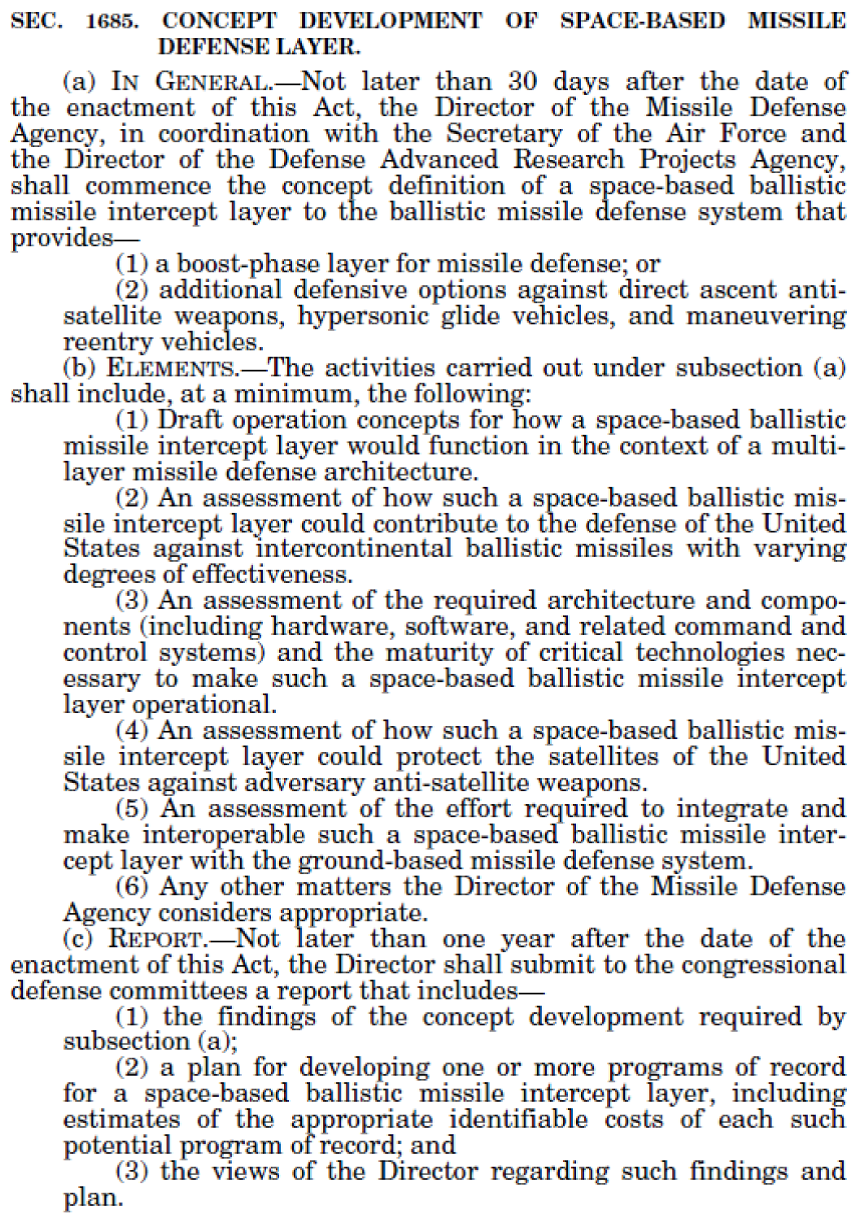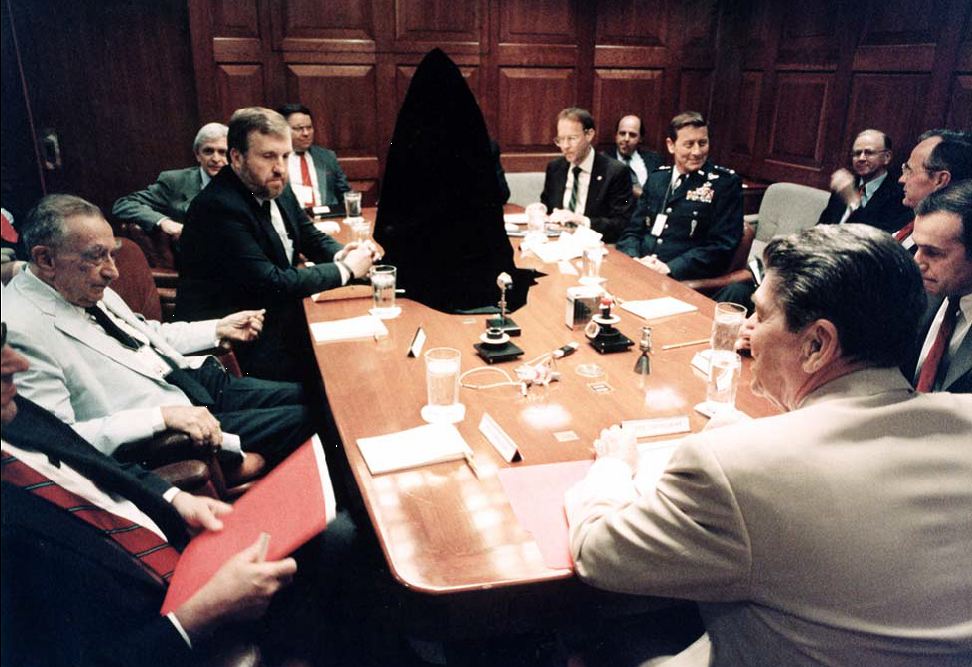“Adversaries are developing kinetic, directed-energy, and cyber tools to deny, degrade, and destroy our space capabilities.” ~ USAF General John Hyten, Commander of Air Force Space Command, from his prepared March 15, 2016 testimony to the Strategic Forces Subcommittee of the House Armed Services Committee
On the eve of the 33rd anniversary of President Ronald Reagan’s speech that launched his Strategic Defense Initiative (SDI), we complete our current trilogy of messages that in combination indicate: We need to bring “Star Wars, Back to the Future” to get on the “Right Side of the Cost Curve” with space-based ballistic missile defense (BMD) systems we now undeniably need.
Our March 8, 2016 message emphasized that such space-based defenses were central to Reagan’s vision — and as British Prime Minister Margaret Thatcher (and others) said, his commitment to pursuing them ended the Cold War without firing a shot.” His vision died at the end of the SDI decade from 1983-1993, when the Clinton administration “took the stars out of Star Wars” — and nothing has been done since to restore those most important initiatives of the SDI era. A revival now should get us on the now finally recognized necessary “right side of the cost curve” as discussed in our March 15, 2016 message.
This view is made more apparent by important testimony before the Strategic Forces Subcommittee of the House Armed Services Committee last week. Click here for the prepared testimony from General Hyten, the author of the above quote, and others who complemented his views: USAF Lieutenant General David Buck, Commander, Joint Functional Component Command for Space; Mr. Frank Calvelli, Principal Deputy Director, National Geospatial Intelligence Agency; The Honorable Robert Cardillo, Director, National Geospatial Intelligence Agency; The Honorable Doug Loverro, Deputy Assistant Secretary of Defense for Space Policy; and Mr. Dyke Weatherington, Acting Deputy Assistant Secretary of Defense for Space, Strategic, and Intelligence Systems.
I have not yet found links to hearing transcripts or hearing videos of witnesses’ responses to questions from Subcommittee members, and will draw heavily from the very important account by Bill Gertz’s Washington Free Beacon article, “China, Russia Planning Attacks on U.S Satellites,” which I encourage you to read in its entirety.
Gertz reports that General Hyten testified that threats to U.S. space systems have reached a new tipping point, and after years of post-Cold War stagnation foreign states are focused on curbing U.S. space systems. He quoted Hyten as saying that “adversaries understand our reliance on space, and they understand the competitive advantage we derive from space. The need for vigilance has never been greater.”
In particular, Gen. Hyten noted the vulnerability of U.S. Global Positioning System (GPS) satellites which are critical to the operation of U.S. guided weapons, as well as their role in providing navigational information for both military and civilian systems. Disrupting the satellites time capabilities would degrade the military’s ability to conduct precision strike operations used in most weapons systems today.
On the positive side, Hyten said a new joint military-intelligence command center is helping to monitor space threats, such as anti-satellite missile launches, covert killer robot satellites, and ground-fired lasers that can blind or disrupt satellites. The unit is called the Joint Interagency Combined Space Operations Center, located at Schriever Air Force Base, Colorado. The Space Command also is creating 39 cyber mission teams that will be used for defensive and offensive cyber operations involving space systems.
Gertz reports that Lt. Gen. David Buck joined Hyten in testifying that China and Russia pose the most serious threats to space systems. He noted that “Simply stated, there isn’t a single aspect of our space architecture, to include the ground architecture, that isn’t at risk” … and that “Russia views U.S. dependency on space as an exploitable vulnerability and they are taking deliberate actions to strengthen their counter-space capabilities.”
Gen. Buck also stated that China in December created its first dedicated space warfare and cyber warfare unit, called the Strategic Support Forces, for concentrating their “space, electronic, and network warfare capabilities” . . . and that “China is developing, and has demonstrated, a wide range of counter-space technologies to include direct-ascent, kinetic-kill vehicles, co-orbital technologies that can disable or destroy a satellite, terrestrially-based communications jammers, and lasers that can blind or disable satellites” . . . and that “Moreover, they continue to modernize their space programs to support near-real-time tracking of objects, command and control of deployed forces, and long-range precision strikes capabilities.”
Gertz reported that Deputy Assistant Secretary Loverro also warned about growing threats to satellites and outlined U.S. plans to deter future attacks — and while he said the United States does not want a war in space, he added “But let me be clear about our intent — we will be ready.” Gertz wrote that Loverro suggested U.S. defense and deterrence of space attacks could involve counter attacks, possibly on the ground or in cyber space, but provided no specifics.
Most important from my perspective, that, Mr. Loverro, in speaking for the Pentagon’s Space Policy, is reported to have said,
“Today our adversaries perceive that space is a weak-link in our deterrence calculus” . . . and that “Our strategy is to strengthen that link, to assure it never breaks, and to disabuse our adversaries of the idea that our space capabilities make tempting targets.”
Deputy Assistant Secretary of Defense for Space Policy Doug Loverro
The issue is just how shall we reach Loverro’s stated objective?
Some hints of measures in that direction are provided by other quotes from Gertz’s most informative article. For example, Loverro apparently argued that deterrence against foreign nations’ space attacks is to be based on defending against missile strikes or other attacks and making sure satellite operations will not be disrupted in war — to be implemented through partnering with the growing commercial space sector that is expected to deploy hundreds of new satellites that could be used to back-up Pentagon systems in a conflict and through partnerships with allied nations in gathering intelligence on space threats.
Loverro also apparently mentioned an unelaborated space defense “offset” strategy seeking to reduce the advantage of adversaries using relatively low cost of missiles, small satellites, or cyber forces to attack U.S. satellites. This echoes the need to “get on the right side of the cost curve” as discussed in last week’s message.
Other testimony also hinted at what I believe would be important steps toward that end — for example, using the technology demonstrated by small inexpensive satellites as discussed by Mr. Calvelli in speaking for National Reconnaissance Office (NRO), the spy agency that builds and operates strategic intelligence and reconnaissance satellites. He revealed a new satellite was launched last October carrying 13 smaller “CubeSats” — nine sponsored by the NRO and four by the National Aeronautics and Space Administration (NASA).
While these “CubeSats” might be listed for other missions, the overarching architecture sounds like the same employed a quarter century ago by SDI considerations of the Space Based Interceptor (SBI) systems. And as discussed in my preceding two messages, the most cost-effective SDI concept for getting on the right side of the cost curve was the Brilliant Pebbles SBI system.
Thus, the groundwork was laid a quarter century ago to revive the most cost-effective missile defense concept developed during the SDI era—at least as seen by SDI Directors during that era and reported to celebrate the 30th anniversary of President Reagan’s March 23, 1983 speech.
Moreover, the Missile Defense Agency, the U.S. Air Force and the Defense Advanced Projects Agency (DARPA) have been directed by the National Defense Authorization Act for Fiscal Year 2016 to provide recommendations for such a concept before the end of Calendar Year 2016. See the pertinent section below.
 In particular, it seems to me that DARPA is particularly well positioned to make a significantly important contribution to this important report, because of its heritage in extending another SDI program that provided a unique step forward in reducing the costs of launching satellites. Such launch costs are a major component of deploying any space system—and particularly one that might include a large number of satellites.
In particular, it seems to me that DARPA is particularly well positioned to make a significantly important contribution to this important report, because of its heritage in extending another SDI program that provided a unique step forward in reducing the costs of launching satellites. Such launch costs are a major component of deploying any space system—and particularly one that might include a large number of satellites.
I speak of the DC-X or Clipper Graham program begun by my predecessor SDI Director USAF Lieutenant General George Monahan and the development of which on my watch I advocated successfully as a single-stage-to-orbit way to reduce the costs of providing targets to test BMD systems, a major source of costs and risks in developing such systems. See my tribute to Bill Gaubatz, a tireless technical advocate, engineering innovator and team builder to advance our national space capabilities.
Bill’s expertise was most clearly demonstrated by worldwide television accounts on August 18, 1993 of the launch of the DC-X, or Clipper Graham as it was sometimes dubbed—because High Frontier’s founder General Danny Graham was instrumental in persuading “the powers that be” to initiate this important innovative program and, on his death bed, quite appropriately received NASA’s highest award as a fitting tribute.
This first rocket and its improved components landed and flew again—a feat repeated 12 times before failing, and set the stage for a reusable launch capability still to be completely harnessed by the subsequent powers that be—though the current generation of space innovators—linked to that past—are nearing that day.
Click here to see a video of the eighth successful DC-X test which took off, turned horizontal to fly sideways, and then righted itself to land nearby—all on the White Sands Test Range.
Fast forward to today. Jess Sponable, who was the SDI Program Manager for that innovative program, now heads the DARPA activities seeking to exploit today’s technology to move our space launch capabilities much further ahead. At the 20th anniversary of the DC-X/Clipper Graham team in August 2013, Jess reported that he and Bill Gaubatz sent a short email to SpaceX CEO and CTO Elon Musk, congratulating them on the recent successful flight of their “Grasshopper vehicle,” a vertical takeoff and landing vehicle—like the DC-X, to an altitude of 250 meters and for the first time moving it to the side 100 meters before making a precision landing.
Musk’s response: “Thanks. Just continuing the great work of the DC-X project!”
Perhaps the DC-X lightning will strike again. Perhaps, indeed! And note that SpaceX is now formally qualified to compete for Pentagon and NASA space launch services — clear evidence of what the private sector can do when effectively challenged and led.
Recall that launch costs are a major component for deploying space based BMD systems—and moreover, new architectures may result from combining “light CubeSats” with innovative launch concepts that build on the DC-X/Clipper Graham legacy. (As I recall, the launch strategy for Brilliant Pebbles included 100 Pebbles on each Atlas space launch platform.)
As mentioned in the first two messages of this “Star Wars Trilogy,” the possibility of private sector initiation fits within Defense Secretary Ashton Carter’s challenge to the technology leaders in meetings in Seattle a couple of weeks ago.
So, why not include a major variant of Ash’s challenge in responding to the NDAA 2016? That should be a priority for DARPA’s contribution to the Report to Congress due by the end of this year.
The picture below recalls the important meeting with President Reagan that launched the most important BMD system concept of the SDI era — under the cloak on the table was a full scale model of a then highly classified Brilliant Pebble, the basic element of the first SDI concept to pass fully the entire Defense Acquisition Board reviews, including costing and an intense “Season of Studies” as labeled by historian Don Baucom, demanding plausible designs and technological innovation against a panoply of demanding offensive countermeasures, to enter a formal Demonstration and Validation (DemVal) Program. Click here for Baucom’s “The Rise and Fall of Brilliant Pebbles.”
This is a fitting remembrance for the 33rd anniversary of President Reagan’s speech that launched the SDI program. Nothing since has remotely competed with the promise of this most cost-effective BMD system concept from the SDI era. And President Reagan’s initiative even at this meeting was to overrule the dominant congressional view and the Pentagon’s bureaucratic lethargy and to move the best of his SDI legacy ahead at a critical moment. Reagan was right then—wish he were in charge today!
Now, after two decades, it truly is time to “go back to the future” and “reverse the cost curve.”
Bottom Lines!
As should be clear from our “Star Wars Trilogy” that needed innovation is possible — and is entirely consistent with Defense Secretary Ashton Carter’s proposals in his March 3, 2016 breakfast discussions at Microsoft in Seattle, urging technologists to come to the aid of our national security needs, under their own initiative.
The technology was available twenty years ago to build and deploy a very effective missile defense system on the “right side of the cost curve.” The Pentagon has invested in a number of missile defense systems many times what was needed to develop, deploy and operate such a global space-based defensive system to protect the American people and our overseas troops, allies and friends. It’s time to get it right!
Reagan was right, by golly!
Near-Term High Frontier Plans.
We will continue to inform our readers of the looming threats we confront — and where appropriate urge them to engage in countering those threats. We will press for building the most cost-effective ballistic missile defenses possible and working with South Carolina folks to build a coalition to engage constructively with private citizens and their local and state representatives and other authorities to work with the SC National Guard in understanding and responding to the existential threats to the electric power grid.
We are especially focused on the nuclear power reactors that produce 60-percent of SC electricity—and more generally 20-percent of the nation’s electricity. If it can be assured that they “operate through” a major blackout of the electric power grid — and I believe it can, then these reactors can play a very important role for resurrecting the grid over an extended time and supporting the general public’s survival in the meantime.
See the new figure just added to the top of our webpage for an illustration of how wind patterns might carry far and wide any significant radiation from the nation’s reactors if we don’t get this right!
What can you do?
Join us in praying for our nation, and for a rebirth of the freedom sought, achieved and passed to us by those who came before us.
Help us to spread our message to the grass roots and to encourage all “powers that be” to provide for the common defense as they are sworn to do.
Begin by passing this message to your friends and suggest they visit our webpage www.highfrontier.org, for more information. Also, please encourage your sphere of influence to sign up for our weekly e-newsletter.
Encourage them to review our past email messages, posted on www.highfrontier.org, to learn about many details related to the existential manmade and natural EMP threats and how we can protect America against them. I hope you will help us with our urgently needed efforts, which I will be discussing in future messages.
Click here to make a tax deductible gift. If you prefer to mail a check, Please send it to 500 North Washington Street, Alexandria, VA 22314.
E-Mail Message 160322
Please click here to read Past Weekly Updates!
Please help High Frontier continue this important and timely work!
Be sure to follow us on our Social Sites!
If you found this letter via our Social Sites, and you would like to subscribe, please click below!






